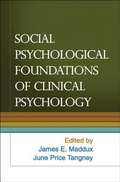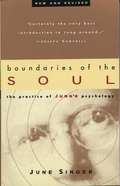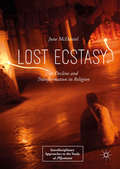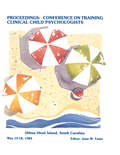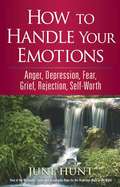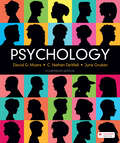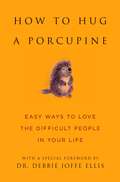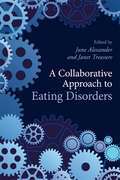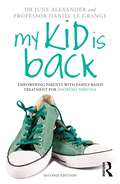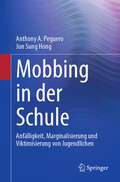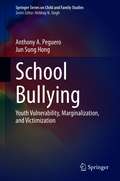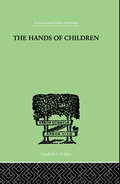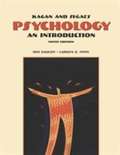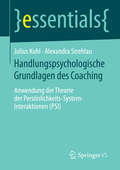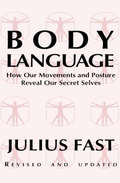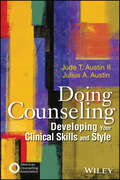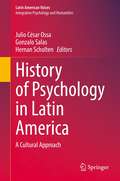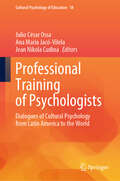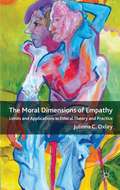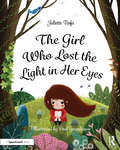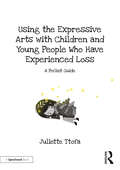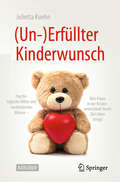- Table View
- List View
Social Psychological Foundations of Clinical Psychology
by June Tangney James MadduxUniquely integrative and authoritative, this volume explores how advances in social psychology can deepen understanding and improve treatment of clinical problems. The role of basic psychological processes in mental health and disorder is examined by leading experts in social, clinical, and counseling psychology. Chapters present cutting-edge research on self and identity, self-regulation, interpersonal processes, social cognition, and emotion. The volume identifies specific ways that social psychology concepts, findings, and research methods can inform clinical assessment and diagnosis, as well as the development of effective treatments. Compelling topics include the social psychology of help seeking, therapeutic change, and the therapist client relationship.
Boundaries of the Soul: The Practice of Jung's Psychology
by June SingerNow, in a completely revised edition of Boundaries Of The Soul, Dr. Singer incorporates the latest developments in Jungian psychology over the last two decades, particularly in the areas of masculine/feminine relationships, the use of psychotherapeutic drugs, and the evolution of Jung's concept and personality types and its application both clinically and in the world of business and industry. In addition, the case histories, so central to understanding many of Jung's concepts, have been re-examined and revised where necessary to correspond to the spirit of today's world. The updated edition of Boundaries of the Soul should reaffirm the book's long-standing reputation as the best introduction to Jung's thought available.
Lost Ecstasy: Its Decline and Transformation in Religion (Interdisciplinary Approaches to the Study of Mysticism)
by June McDanielThis book is a study of religious ecstasy, and the ways that it has been suppressed in both the academic study of religion, and in much of the modern practice of religion. It examines the meanings of the term, how ecstatic experience is understood in a range of religions, and why the importance of religious and mystical ecstasy has declined in the modern West. June McDaniel examines how the search for ecstatic experience has migrated into such areas as war, terrorism, transgression, sexuality, drug use, and anti-institutional forms of spirituality. She argues that the loss of religious and mystical ecstasy, as both a religious goal and as a topic of academic study, has had wide-ranging negative effects. She also proposes that the field of religious studies must go beyond criminalizing, trivializing and pathologizing ecstatic and mystical experiences. Both religious studies and theology need to take these states seriously as important aspects of lived human experience.
Proceedings of the Conference on Training Clinical Child Psychologists
by June M. TumaThis volume is derived from the conference on Training Clinical Child Psychologists held in South Carolina. The goal of the meeting was to identify, examine, and assess the major influences, directions, goals, and actions of consequence to clinical child psychology and to clinical child psychologists. Proceedings: Conference on Training Clinical Child Psychologists explores issues pertaining to the goal of training competent psychologists to work with children, youths, and families. The objectives of this volume and the conference are: *to stimulate discourse meaningful to clinical child psychologists and to the total psychological community; *to clarify major issues and alternative actions, and*to formulate and implement feasible proposals for strengthening the professional preparation of clinical child psychologists. Topics included in this volume include: roles and responsibilities of clinical child psychologists and the boundary issues; curriculum issues; models of training; credentialing and licensing; and recommendations, guidelines and conclusions drawn from the conference. Also included are the Guidelines for Training Psychologists to Work with Children Youths, and Families (Appendix E). Contributors include: June M. Tuma, Donald K. Routh, Michael C. Roberts, Patricia J. Aletky, Stanley F. Schneider, Alan O. Ross, Honore M. Hughes, Anthony P. Mannarino, Thomas H. Ollendick, Annette M. LaGreca, Carolyn Schroeder, Jerome H. Hanley, David S. Glenwick, Steven M. Neuhaus, Frank D. Fincham, Gary B. Melton, Douglas G. Ullman, Howard Markam, William O. Donnelly, Sandra W. Russ, Donald K. Freedheim, Jane W. Kessler, Donald Wertleib, Dennis Drotar, Andrew S. Bradlyn, Lynne Doran, Sheila Eyberg, James H. Johnson, Jean C. Elbert, Robert D. Felner, Raymond P. Lorion, Al Finch, Diane J. Willis, Marilyn T. Erickson, Martha Perry, Richard R. Abidin, Felicisima C. Serafica, Charles Wenar, S. Joseph Weaver, Jacquelin Goldman, Rochelle L. Robbins.
How to Handle Your Emotions: Anger, Depression, Fear, Grief, Rejection, Self-worth
by June HuntThe first of an exciting new series of topical counseling resources offering God's truth for today's problems! Every person struggles with the common emotions related to anger, depression, fear, rejection, self-worth. How can we prevent negative emotions from getting the best of us? Longtime biblical counselor June Hunt looks to the Bible for the answers, offering compassionate guidance that encourages the heart and offers hope for even the most difficult situations. Each of the above topics is explored in four parts, examining the definitions, the characteristics, the causes, and the solutions that enable us to handle our emotions in ways that honor God and bless the people around us. At every step of the way, valuable insights are gleaned from Scripture. Written with a strong emphasis on practical applications that make a lasting difference, this guide is perfect for use by individuals, friends, small groups, and ministry workers.
Psychology
by David G. Myers C. Nathan DeWall June GruberThe number #1 bestselling intro to psychology in an exhaustively updated new edition.
How to Hug A Porcupine
by June Eding Dr Debbie Joffe EllisHow to Love the Difficult People in Your LifeMost of us know someone who, for whatever reason, always seems to cause problems, irritate others, or incite conflict. Often, these people are a part of our daily lives. The truth is that these trouble makers haven't necessarily asked to be this way. Sometimes we need to learn new approaches to deal with people who are harder to get along with or love.How to Hug a Porcupine: Easy Ways to Love Difficult People in Your Life, explains that making peace with others isn't as tough or terrible as we think it is-especially when you can use an adorable animal analogy and apply it to real-life problems.How to Hug a Porcupine provides tips for calming the quills of parents, children, siblings, strangers, and other prickly people you may encounter. Among other tips, How to Hug a Porcupine includes: *Three easy ways to end an argument*How to spot the porcupine in others *How to spot the porcupine in ourselvesWith a foreword by noted psychotherapist Dr. Debbie Ellis, widow of Dr. Albert Ellis, How to Hug a Porcupine is a truly special book.
A Clinician's Guide to Binge Eating Disorder
by Daniel Le Grange June Alexander Andrea B. GoldschmidtIncidence of BED appears to be on the increase. Treating it, and overcoming it, is all the more difficult, especially for those living in a culture that has an intense body image focus. A Clinician’s Guide to Binge Eating Disorder educates the reader about its triggers and behaviours – and describes steps to treat it and resume a full and productive life. Evidence-based research outcomes provide the framework and foundation for this book. First-person case studies bring application of this science to life to help close the gap between research and treatment/care, and the importance of clinicians developing a therapeutic relationship as a healing tool with their client is discussed, recognizing that medical and psychological dimensions are inextricably intertwined. This book allays fear of the unknown, explains the emotional chaos that can sweep in like a storm when, unintentionally, triggers are released. It provides practical steps and footholds for clinicians and researchers to help the patient take control of their life and look to a positive future.
A Collaborative Approach to Eating Disorders
by Janet Treasure June AlexanderWhile many aspects of eating disorders remain a mystery, there is growing evidence that collaboration is an essential element for treatment success. This book emphasises and explains the importance of family involvement as part of a unified team approach towards treatment and recovery. A Collaborative Approach to Eating Disorders draws on up-to-date evidence based research as well as case studies and clinical vignettes to illustrate the seriousness of eating disorders and the impact on both the sufferer and their loved ones. Areas of discussion include: current research including genetic factors, socio-cultural influences and early intervention clinical applications such as family based dialectical and cognitive behavioural treatments treatment developments for both adolescents and adults with a range of eating disorders building collaborative alliances at all levels for treatment and ongoing recovery. With contributions from key international figures in the field, this book will be a valuable resource for students and mental health professionals including family doctors, clinicians, nurses, family therapists, dieticians and social workers.
Anorexia Nervosa: A Recovery Guide for Sufferers, Families and Friends
by Janet Treasure June AlexanderThe highly respected and widely known Anorexia Nervosa: A Survival Guide for Sufferers and Friends was written in 1997. This long-awaited new edition builds on the work of the first book, providing essential new and updated research outcomes on anorexia nervosa. It offers a unique insight and guidance into the recovery process for those who suffer from an eating disorder as well as advice and information for their loved ones. Written collaboratively by both an expert in the field and someone with personal experience of eating disorders, this book offers exceptional understanding of the issues surrounding the illness. Divided into four sections, it includes: an outline of anorexia nervosa coping strategies for sufferers advice and information for families, carers and friends guidelines for professionals who are involved in the sufferer’s life. Families, friends, carers and professionals such as teachers and GPs are encouraged to read all sections in order to fully understand the illness. With an emphasis on collaboration and a layout that enables content to be referenced and read in any order, this book is an essential resource for anyone affected, directly or indirectly, by anorexia nervosa.
My Kid is Back: Empowering Parents with Family-Based Treatment for Anorexia Nervosa
by June Alexander Daniel Le GrangeWhen anorexia nervosa (AN) develops in a child, it impacts the entire family. However, family-based treatment (FBT) offers hope by reinstating fundamental family coping principles—empowering parents and supporting them and their children in overcoming this serious psychiatric illness.My Kid is Back serves as an accessible guide to understanding FBT for parents of children with AN and the healthcare professionals working with them. Through a series of first-person interviews held with the parents, the siblings, and the child with anorexia, this book vividly presents the daily, 24/7 challenges of the illness on the family. Parents describe their frustrations in seeking help for their child, and sufferers discuss how the illness gets into their mind. Supplementing chapters detail how to tell if your child has AN, present an approachable explanation of FBT, and describe how to navigate the search for FBT. This second edition includes updated evidence-based research findings and revised content, language, and family resources. The featured case studies have been updated to be more neurodiverse, gender diverse, and ethnically diverse, as compared with the first edition. Presented in a way that parents, doctors, and treatment teams can readily relate to and understand, this book proves an essential resource for families who want to win the battle with anorexia nervosa.
Using Writing as a Therapy for Eating Disorders: The diary healer
by June AlexanderUsing Writing as a Therapy for Eating Disorders: The diary healer uses a unique combination of evidence-based research and raw diary excerpts to explain the pitfalls and benefits of diary writing during recovery from an eating disorder. In a time when diary writing remains a largely untapped resource in the health care professions, June Alexander sets out to correct this imbalance, explaining how the diary can inspire, heal and liberate, provide a learning tool for others and help us to understand and cope with life challenges. The book focuses on the power of diary writing, which may serve as a survival tool but become an unintended foe. With guidance, patients who struggle with face-to-face therapy are able to reveal their thoughts through writing and construct a strong sense of self. The effects of family background and the environment are explored, and the therapeutic value of sharing diaries, to better understand illness symptoms and behaviours, is discussed. Using Writing as a Therapy for Eating Disorders will be of interest to those who have recovered or are recovering from eating disorders or any mental illness, as well as therapists, clinicians and others working in the medical and healthcare professions.
Mobbing in der Schule: Anfälligkeit, Marginalisierung und Viktimisierung von Jugendlichen
by Anthony A. Peguero Jun Sung HongDieses Buch untersucht die damit verbundenen Erfahrungen mit Mobbing und Gewalt in der Schule bei gefährdeten und marginalisierten Jugendlichen. Es erörtert die Auswirkungen von Diversität und Ungleichheiten in den Erfahrungen von Jugendlichen mit Mobbing. Dazu gehören sozioökonomischer und sozialer Status, familiärer Zusammenhalt und Interaktionen, Geschlecht, sexuelle Orientierung, Geschlechtsidentität und -ausdruck, Rasse, ethnische Zugehörigkeit, Einwanderung, Religion sowie Behinderungen und besondere gesundheitliche Bedürfnisse. Das Buch beschreibt die Art und Weise, wie ein sozial-ökologischer Rahmen über das Problem informieren und Mobbing an Schulen angehen kann. Es befasst sich nicht nur mit den individuellen, intrapersonellen und umweltbedingten Faktoren von Mobbing, sondern erörtert auch Faktoren auf der distalen Ebene und Bedingungen, die speziell fürJugendliche relevant sind (z. B. Kultur und Recht). Darüber hinaus kontextualisiert dieser Band relevante Mehrebenenfaktoren, die die Viktimisierung durch Mobbing bei gefährdeten und historisch marginalisierten Kindern und Jugendlichen, die mit einer kumulativen sozialen Schichtung konfrontiert sind, fördern oder verhindern.Zu den wichtigsten Themenbereichen gehören:· Die Rolle der Familie (Eltern und Erziehungsberechtigte, Geschwister) - ihr Zusammenhalt und ihre Interaktionen - bei Mobbing in der Schule.· Rasse, ethnische Zugehörigkeit, Einwanderung und Religion sowie Mobbing in der Schule bei marginalisierten und gefährdeten Jugendlichen.· Viktimisierung von Schülern mit körperlichen, emotionalen und Lernstörungen.· Mobbing und Viktimisierung gefährdeter Jugendlicher in den Gerichtssystemen.Mobbing in der Schule ist ein unverzichtbares Hilfsmittel für Forscher, Kliniker und andere Praktiker, Studenten und politische Entscheidungsträger in Disziplinen wie Kinder- und Schulpsychologie, Sozialarbeit und Beratung, Pädiatrie und Schulpflege, Bildungspolitik und Politik sowie in allen miteinander verbundenen Disziplinen.
School Bullying: Youth Vulnerability, Marginalization, and Victimization (Springer Series on Child and Family Studies)
by Anthony A. Peguero Jun Sung HongThis book examines the associated experiences of school bullying and violence among vulnerable and marginalized youth. It discusses the effects of diversity and disparities in youth’s experiences with bullying. Among these are socioeconomic and social status, family cohesion and interactions, sex, sexual orientation, gender identity and gender expression, race, ethnicity, immigration, religion, and disabilities and special health needs. The book describes the ways in which a social-ecological framework can inform the problem and address school bullying. It addresses not only individual, intrapersonal, and environmental factors of bullying, but also discusses distal level factors and conditions that are specifically relevant to youth (e.g., culture and law). In addition, this volume contextualizes relevant multilevel factors that foster or inhibit bullying victimization among vulnerable and historically marginalized children and adolescents who are faced with cumulative social stratification. Key areas of coverage include: The role of the family (parents and guardians, siblings) – its cohesion and interactions – in school bullying.Race, ethnicity, immigration, and religion and school bullying of marginalized and at-risk youth.Victimization of students with physical, emotional, and learning disorders.Bullying and victimization of vulnerable youth in the court systems. School Bullying is an essential resource for researchers, clinicians and other practitioners, graduate students, and policymakers across such disciplines as child and school psychology, social work and counseling, pediatrics and school nursing, educational policy and politics, and all interrelated disciplines.
The Hands Of Children: AN INTRODUCTION TO PSYCHO-CHIROLOGY (International Library Of Psychology Ser.)
by Julius SpierThis is Volume XVIII in a series of twenty-one in a collection on Individual Differences. Originally published in 1931, this posthumously published work provides the reader with an introduction to psych-chirology with additions by the current editor's experiments and anaylsis. With an Appendix on the Hands of the Mentally Diseased by Herta Levi.
Kagan and Segal's Psychology: An Introduction (9th edition)
by Jerome Kagan Julius Segal Ernest Havemann Don Baucum Carolyn D. SmithContinuing with the character and spirit of previous editions, Don Baucum and Carolyn Smith join Jerome Kagan and Julius Segal to create a streamlined text with a free integrated study guide. The text follows a developmental theme, with an emphasis on diversity coverage and critical thinking. In many chapters, the developmental theme is highlighted by a Life Span Perspective feature that shows students the relevance of chapter topics to the development of a human life, and that helps them make connections between themes discussed in different chapters. Personal applications and real-life examples are included throughout the text to engage students in every key topic area.
Handlungspsychologische Grundlagen des Coaching: Anwendung der Theorie der Persönlichkeits-System-Interaktionen (PSI) (essentials)
by Julius Kuhl Alexandra StrehlauCoaching fördert die Entwicklung der Selbststeuerungsfähigkeiten des Klienten, die für die Lösung eines Problems oder die Erreichung eines (meist) beruflichen Ziels bedeutsam sind. In diesem Beitrag wird die Persönlichkeits-System-Interaktions-Theorie (PSI-Theorie) dargestellt, mit der verschiedene Persönlichkeitstheorien, wissenschaftliche Befunde und neurobiologische Grundlagen zu einer Theorie der willentlichen Handlungssteuerung verbunden werden. Mit Hilfe der PSI-Theorie können nicht nur Prozesse der Selbststeuerung theoretisch erklärt werden, sondern sie bietet auch eine Grundlage dafür, das professionelle Handeln im Coaching systematisieren und definieren zu können.
Body Language: The Essential Secrets Of Non-verbal Communication
by Julius FastA revised and updated edition of the New York Times–bestselling classic on understanding body language from the author of Subtext.Body Language helps you to understand the unconscious body movements and postures that provide intimate keys to what a person is really thinking and the secrets of their true inner selves. You will learn how to read the angle of shoulders, the tilt of a head, or the tap of a foot, in order to discern whether an individual is angry, frightened, or cheerful. You will be able to use Body Language to discover the most—and least—important person in any group by the way others position themselves. The body is not able to lie, for it sends subtle signals to those who know how to read them. Body Language will even show you how to do it without others knowing you are observing them. Body Language was a huge best seller when first published and has remained in print ever since. It has been thoroughly updated and revised especially for this ebook edition.
Doing Counseling: Developing Your Clinical Skills and Style
by Jude T. Austin II Julius A. AustinThis pragmatic book explains the “how” of integrating counselor training into practice by bridging the gap between educational knowledge, clinical skill, and counselor identity. Drs. Jude and Julius Austin combine their personal and professional experiences with contributions from other skilled clinicians to break down the counseling process and inspire counselor confidence in the ongoing quest to do counseling well. Following an introduction to basic counseling ethics and several types of sessions, each stage of counseling is explored, including presession preparation, meeting the client, building the therapeutic relationship, managing and trusting the process, developing a unique personal style, tracking therapeutic progress, ending therapy, and postsession tasks. The discussion then shifts to getting the most from supervision, competent multicultural/antiracist counseling, and the dos and don’ts of distance counseling. A sole case study is presented throughout the book to illustrate therapeutic techniques, and key takeaways are summarized in an epilogue. *Requests for digital versions from ACA can be found on www.wiley.com *To purchase print copies, please visit the ACA website here*Reproduction requests for material from books published by ACA should be directed to permissions@counseling.org
History of Psychology in Latin America: A Cultural Approach (Latin American Voices)
by Julio César Ossa Gonzalo Salas Hernan ScholtenThis book presents a cultural history of psychology that analyzes the diverse contexts in which psychological knowledge and practices have developed in Latin America. The book aims to contribute to the growing effort to develop a theoretical knowledge that complements the biographical perspective centered on the great figures, with a polycentric history that emphasizes the different cultural, social, economic and political phenomena that accompanied the emergence of psychology. The different chapters of this volume show the production of historians of psychology in Latin America who are part of the Ibero-American Network of Researchers in History of Psychology (RIPeHP, in the Portuguese acronym for "Rede Iberoamericana de Pesquisadores em História da Psicologia"). They present a significant sample of the research carried out in a field that has experienced a strong development in the region in the last decades. The volume is divided into two parts. The first presents comparative chapters that address cross-cutting issues in the different countries of the region. The second part analyzes particular aspects of the development of psychology in seven countries: Argentina, Brazil, Chile, Colombia, Mexico, Paraguay and Peru. Throughout these chapters the reader will find how psychology made its way through dictatorial governments, phenomena of violence and internal armed conflict, among others. Dimensions that include rigorous analysis ranging from ancestral practices to current geopolitical knowledge of the Latin American region. History of Psychology in Latin America - A Cultural Approach is an invaluable resource for historians of psychology, anywhere in the world, interested in a polycentric and critical approach. Since its content is part of the "cultural turn in psychology" it is also of interest to readers interested in the social and human sciences in general. Finally, the thoroughly international perspective provided through its chapters make the book a key resource for both undergraduate and graduate teaching and education on the past and current state of psychology.
Professional Training of Psychologists: Dialogues of Cultural Psychology from Latin America to the World (Cultural Psychology of Education #18)
by Julio César Ossa Ana Maria Jacó-Vilela Jean Nikola CudinaThis book represents an intellectual journey through the history, culture, and training of psychologists in Latin America to transcend borders. It analyzes the inception of academic programs in each country in the region, exploring the socio-political and economic context, and delves into the conceptual, methodological, and epistemological aspects of training. Similarly, it discusses how psychology prepares professionals for their roles in society and provides updated data on the discipline's growth in the region. Furthermore, it promotes international and intercultural dialogue, enriching the global understanding of psychology. The book's emphasis on adopting a historical and cultural approach is essentially an effort to introduce a critical component to the analysis of psychologist professional training. This component adds value for the reader and aids in understanding how Latin American psychology has been shaped by historical events, social movements, government policies,and the diverse cultural traditions of the region. Readers will gain a profound understanding of why psychology has developed in a particular way in each Latin American country, shedding light on significant variations in psychological practice and theory in this part of the world. Essentially, this work constitutes an invaluable resource for academics, professionals, and anyone interested in understanding the intersection between psychology and the rich historical and cultural diversity of Latin America.
The Moral Dimensions of Empathy
by Julinna C. OxleyDoes empathy help us to be moral? The author argues that empathy is often instrumental to meeting the demands of morality as defined by various ethical theories. This multi-faceted work links psychological research on empathy with ethical theory and contemporary trends in moral education.
The Girl Who Lost the Light in Her Eyes: A Storybook to Support Children and Young People Who Experience Loss (Supporting Children and Young People Who Experience Loss)
by Juliette TtofaThis beautifully illustrated and sensitively written storybook has been created to be used therapeutically with children experiencing loss. Telling the story of a young girl who searches high and low for the light that is missing from her eyes, it encourages the child to move through the grieving process in order to find colour in the world again. The colourful illustrations and engaging story are designed to inspire conversation around loss, and will help develop emotional literacy and resilience in children and young people. This book is also available to purchase alongside a pocket guidebook as part of the two-component set, Supporting Children and Young People Who Experience Loss. The full set includes: • The Girl Who Lost the Light in Her Eyes, a colourfully illustrated and sensitively written storybook, designed to encourage conversation and support emotional literacy. • Using the Expressive Arts with Children and Young People Who Experience Loss, a supporting guidebook that explores a relational approach and promotes creative expression as a way through loss or bereavement. Perfectly crafted to spark communication around a difficult topic, this is an invaluable tool for practitioners, educators, parents, and anybody else looking to support a child or young person through loss or bereavement.
Using the Expressive Arts with Children and Young People Who Have Experienced Loss: A Pocket Guide (Supporting Children and Young People Who Experience Loss)
by Juliette TtofaThis guidebook has been created to be used alongside the storybook, The Girl Who Lost the Light in Her Eyes. Using a relational approach, it explores the themes of the story and offers guidance to the adult as they use expressive arts to give the child or young person a creative outlet for their emotions. The gentle guidance offered makes this an ideal tool for non-specialists working with children experiencing loss or bereavement. It guides the adult to respond appropriately and sensitively to the grief of the child, whilst helping them journey through the grieving process. This book must be used alongside the illustrated storybook, The Girl Who Lost the Light in Her Eyes. Both books are available to purchase as a set, Supporting Children and Young People Who Experience Loss. The full set includes: • The Girl Who Lost the Light in Her Eyes, a colourfully illustrated and sensitively written storybook, designed to encourage conversation and support emotional literacy. • Using the Expressive Arts with Children and Young People Who Experience Loss, a supporting guidebook that explores a relational approach and promotes creative expression as a way through loss or bereavement. Perfectly crafted to spark communication around a difficult topic, this is an invaluable tool for practitioners, educators, parents, and anybody else looking to support a child or young person through loss or bereavement.
(Un-)Erfüllter Kinderwunsch: Psychologische Hilfen und medizinisches Wissen – was Paare in der Kinderwunschzeit ihrem Ziel näher bringt
by Julietta KuehnDie Kinderwunschzeit ist mit einem hohen Leidensdruck und Zukunftsängsten verbunden. Betroffene Paare durchlaufen verschiedene emotionale Entwicklungsphasen und stehen immer wieder vor neuen Herausforderungen. Manchmal ist die Sehnsucht nach einem Baby gar so groß, dass ein Tunnelblick, vermehrtes Grübeln und angstbesetzte Gedanken den Alltag negativ beeinflussen. Wenn Verbissenheit, Trauer, Verzweiflung oder Hoffnungslosigkeit lähmend wirken, kann ein Perspektivenwechsel die Offenheit für alternative Wege stärken.Mit diesem Ratgeber erhalten Sie während dieser facettenreichen, schweren Lebenssituation Unterstützung durch eine erfahrene Medizinerin, Psychotherapeutin und Betroffene. Vor allem wenn reproduktionsmedizinische Maßnahmen in Anspruch genommen werden, ist der Erhalt der körperlichen und geistigen Gesundheit eine Grundvoraussetzung, um diese Zeit möglichst gelassen und ohne Folgeerscheinungen zu überstehen.Auf die Kinderwunschzeit abgestimmte Übungen, konkrete Hilfsangebote und Erfahrungsberichte bieten Ihnen eine lösungsorientierte, mitfühlende Bewältigungshilfe. Loslassen ist in dieser Zeit genauso wichtig, wie die Konkretisierung neuer Wege, damit Sie Ihrem Wunschziel näher kommen.
